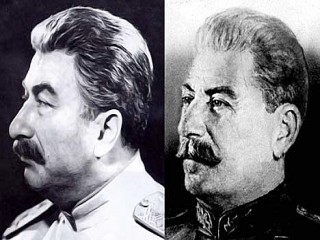
Stalin, Joseph biography
Date of birth : 1878-12-18
Date of death : 1953-03-05
Birthplace : Gori, Tiflis Governorate, Russian Empire
Nationality : Russian
Category : Historian personalities
Last modified : 2010-04-13
Credited as : Military and totalitarian leader of the Soviet Union, revolutionary activities, follower of Vladamir Lenin
3 votes so far
Stalin launched a command economy, replacing the New Economic Policy of the 1920s with Five-Year Plans and launching a period of rapid industrialization and economic collectivization. The upheaval in the agricultural sector disrupted food production, resulting in widespread famine, such as the catastrophic Soviet famine of 1932-1933, known in Ukraine as the Holodomor.
Joseph Stalin was the dictator of the Soviet Union from 1929 to 1953. During these years he epitomized the totalitarian leader, transforming Soviet society according to his personal wishes and using the state to imprison and kill millions of people so as to maintain total control. The use of secret police, torture and prison camps called gulags marked Stalin's obsessive need to eliminate real and imagined political enemies. His expansionist foreign policy after World War II contributed to the Cold War and the proliferation of nuclear weapons.
The son of peasants, he studied for the priesthood before becoming a socialist in 1899. He was repeatedly arrested, imprisoned and exiled between 1902 and 1913 for his increasingly aggressive revolutionary activities. Changing his name to Stalin in 1910, he became a follower of Vladamir Ilich Lenin, who led the Bolshevik wing of the Russian Social Democrats. Lenin soon recognized his talents but Stalin was again arrested by Russian authorities and sent to Siberia in 1913. He would remain in exile during World War I and observed the crumbling of the Russian monarchy in 1917. He returned that year to help the Bolsheviks in the November Revolution that established a Communist government. Stalin remained close to Lenin during the next three years as the Communists fought a civil war against democratic forces.
Though a revolutionary, Stalin was more interested in personal power. He began to position himself for eventual leadership and when Lenin died in 1924, he began to methodically eliminate his rivals. During the late 1920s he and Leon Trotsky fought for control of the Communist Party and the Soviet government. Trotsky was an intellectual who believed in world revolution, while Stalin was a politician who sought to consolidate the Soviet state. By 1929 Stalin had become the leader of party and government and Trotsky was forced into exile.
During the early 1930s Stalin wished to put his stamp on Soviet society. He eliminated private farms and he imposed strict controls over the many ethnic minority states that were part of the Soviet Union. As ruthless as he was in imposing his economic and social views on the nation, Stalin was much more severe in controlling the Communist Party. He worried about Trotsky and directed several assassination plots that finally led to Trotsky's death in Mexico in the mid-1930s. Domestically, Stalin had real or imagined rivals in party leadership assassinated or brought to trial on false criminal charges. The "show trials"of the late 1930s disturbed many left-wing leaders around the world, as the defendants showed signs of torture and coercion as they confessed to imagined acts of treason. These trials became a symbol of the Stalinist state, as the defendants had clearly been brutalized into confessing the errors of their ways. The trials also demonstrated the use of the criminal law to further political ends. The Soviet legal system was simply a mechanism to carry out the wishes of Stalin. What the world did not know was Stalin's imprisonment of millions of people in labor camps for similar disloyalty to the state.
In 1939 Stalin stunned the world when he signed a nonaggression pact with Nazi Germany. All was explained weeks later when Germany invaded Poland. Stalin was allowed to invade eastern Poland and the following year the Soviet Union overran the Baltic states of Estonia, Latvia, and Lithuania. However, when Hitler invaded the Soviet Union in June 1941, Soviet forces were quickly overwhelmed. Retreating deep into Russia, the Soviet troops were soon aided by the Russian winter. Stalin aligned the Soviet Union with the United States and Great Britain and together they defeated Germany in 1945. However, Soviet forces remained in Germany and in Eastern Europe. Stalin set up puppet Communist states in these countries.
The United States and the Soviet Union were soon locked in a Cold War. Stalin's uncompromising positions led to a military buildup in both countries. In the United States, the Soviet Union went from an heroic ally in war to a despised, sinister force that threatened the destruction of democracy. Stalin's monolithic Communism suggested that he would use any means to advance his personal and political goals. Moreover, he had manufactured a "cult" of Stalin that portrayed him in heroic, almost God-like terms. By 1950 his ruthlessness and total control of the state had paralyzed Soviet society.
The Stalin era finally ended on March 5, 1953, when he died of a brain hemorrhage. However, his legacy lived on with future Soviet leaders.
















